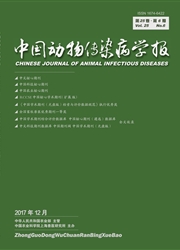

 中文摘要:
中文摘要:
黄病毒E蛋白结构域Ⅲ能够介导病毒与宿主受体结合以及诱导产生中和抗体,本研究利用原核表达系统表达了鸭坦布苏病毒E蛋白结构域Ⅲ,并研究了其免疫原性。按照大肠杆菌偏好性密码子对鸭坦布苏病毒E蛋白结构域Ⅲ核苷酸序列进行优化并合成后,克隆至pCold-TF载体构建重组质粒pCold-TF-optiEDIII。Western blot证实重组蛋白能与鸭坦布苏病毒特异性血清发生反应。用纯化的重组蛋白免疫BLAB/c小鼠3次,间接ELISA和间接免疫荧光实验证实E蛋白结构Ⅲ诱导了鸭坦布苏病毒特异性的体液免疫反应。中和实验证实鸭坦布苏病毒E蛋白结构域Ⅲ可诱导产生中和抗体。本研究为进一步研制鸭坦布苏病毒诊断抗原和亚单位疫苗奠定了基础。
 英文摘要:
英文摘要:
The domain III of envelope glycoprotein (E) of the flaviviruses has been shown to bind cellular receptors and elicit neutralizing antibodies. In the present study, recombinant domain III (DIII) of E protein of Duck Tembusu virus (DTMUV) was expressed in E.coli and its immunogenicity was evaluated using BALB/c mouse model. The coding sequence of DIII was optimized (optiDIII) according to the bias codon usages of E.coli and then cloned into the multiple cloning site of pCold-TF vector to construct the recombinant plasmid pCold-TF-optiDIII. Western blot analysis showed the recombinant protein could react specifically with DTMUV antiserum. The recombinant DIII was purified and used to immunize BALB/c mice three times. The humoral immune responses specific for DTMUV were demonstrated by ELISA and indirect immunofluorescene assay(IFA). Importantly, neutralizing antibodies against DTMUV were detected in mouse serum samples by microneutralizing test. These findings have indicated that the recombinant DIII can be used for development of diagnostic reagents and subunit vaccines of DTMUV.
 同期刊论文项目
同期刊论文项目
 同项目期刊论文
同项目期刊论文
 Development of a Blocking ELISA for Detection of Serum Neutralizing Antibodies against Newly Emerged
Development of a Blocking ELISA for Detection of Serum Neutralizing Antibodies against Newly Emerged 期刊信息
期刊信息
